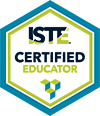
Event Information

Opening and Closing: This session will be presented in an interactive format. Participants will have time to reflect twice on current practices and goals, as well time to conclude with goal-setting through a 3-2-1 technique used at the beginning and end of the session. Time to share peer-to-peer will be provided as time allows.
Session Content: Content will be shared from the presenter's research on digital technology integration into literacy learning in elementary classrooms. This will include an outline of the four steps taken to make decisions about technology platform use in the curriculum and examples of how the teachers used digital platforms to engage students in creative activities to support their literacy learning.
Time for peer discussion and questions about the content will be built into each section of the presentation, approximately four times during the session. Interactive polls will be integrated throughout the session to gauge participant experience and comfort with concepts and techniques at least 3 times.
Introduction and reflection on current practices/experiences - 10 minutes
Overview of the research project and supporting research - 5 minutes
Discussion of the decision-making process for technology integration and example literacy activities - 30 minutes
Goal-setting and questions - 5 minutes
Researchers: Jackie Marsh, New London Group, Karen Wohlwend
Blanchard, J. & Moore, T. (2010). The digital world of young children: Impact on emergent literacy. Pearson Foundation White Paper. Retrieved from
http://www.pearsonfoundation.org/PDF/EmergentLiteracy-WhitePaper.pdf.
Burke, A. & Marsh, J. (Eds.). (2013). Children's virtual play worlds: Culture, learning and participation. New York: Peter Lang.
Coiro, J., Dobler, E., & Pelekis, K. (2019). From curiosity to deep learning: Personal digital inquiry in grades K-5. Portland, ME: Stenhouse.
Cope, B. & Kalantzis M. (2010). From Gutenberg to the internet: How digitsation transforms culture and knowledge. In B. Cope, M. Kalantzis, & L. Magee (Eds.),
Connecting knowledge in academic research: Towards a semantic web (pp. 200-216). Oxford, UK: Chandos Publishing.
Halliday, M. A. K. (1978). Language as social semiotic: The social interpretation of language and meaning. London: Edward Arnold.
Marsh, J. (2005). Children of the digital age. In: J. Marsh (Ed.), Popular culture, new media and digital literacy in early childhood (pp. 1-10). London: Routledge Farmer.
Kress, G. (2010). Multimodality: A social semiotic approach to contemporary communication. New York: Routledge.
Lankshear, C., & Knobel, M. (2011). New literacies: Everyday practices and classroom learning (3rd ed.). Maidenhead, Berkshire: Open University Press.
Leander, K. M. & Sheehy, M. (2004) Spatializing literacy research and practice. New York: P. Lang.
New London Group (1996). A pedagogy of multiliteracies: Designing social futures. Harvard Educational Review, 66(1), 60-92.
Marsh, J., Brooks, G., Hughs, J., Richie, L. & Roberts, S. (2005). Digital beginnings: Young children’s use of popular culture, media, and new technologies. Sheffield, UK: University of Sheffield. Retrieved from http://www.digitalbeginnings.shef.ac.uk/.
Reich, S. M., Korobkova, K. A., Black, R. W., & Sumaroka, M. (2013). Hey! Can you show me how to do this? In A. Burke & J. Marsh (Eds.), Children’s virtual play worlds (pp. 133-150). New York, NY: Peter Lang.
Salmerón, L., Vargas, C., Delgado, P., & Baron, N. (2023). Relation between digital tool practices in the language arts classroom and reading comprehension scores. Reading and writing, 36(1), 175–194. https://doi.org/10.1007/s11145-022-10295-1
Wohlwend, K. E. (2010). A is for avatar: Young children in literacy 2.0 worlds and literacy 1.0 schools. Language Arts, 88(2), 144-152.

